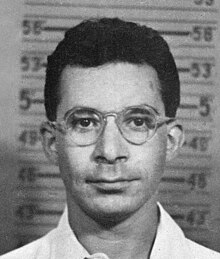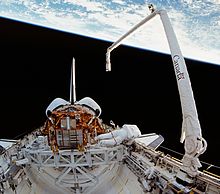Portal:Canada
| Showcase | Contents | Contributing |
Introduction
Canada is a country in North America. Its ten provinces and three territories extend from the Atlantic Ocean to the Pacific Ocean and northward into the Arctic Ocean, making it the world's second-largest country by total area, with the world's longest coastline. Its border with the United States is the world's longest international land border. The country is characterized by a wide range of both meteorologic and geological regions. With a population of just over 41 million people, it has widely varying population densities, with the majority residing in urban areas and large areas of the country being sparsely populated. Canada's capital is Ottawa and its three largest metropolitan areas are Toronto, Montreal, and Vancouver.
Canada is a parliamentary democracy and a constitutional monarchy in the Westminster tradition. The country's head of government is the prime minister, who holds office by virtue of their ability to command the confidence of the elected House of Commons and is appointed by the governor general, representing the monarch of Canada, the ceremonial head of state. The country is a Commonwealth realm and is officially bilingual (English and French) in the federal jurisdiction. It is very highly ranked in international measurements of government transparency, quality of life, economic competitiveness, innovation, education and human rights. It is one of the world's most ethnically diverse and multicultural nations, the product of large-scale immigration. Canada's long and complex relationship with the United States has had a significant impact on its history, economy, and culture.
A developed country, Canada has a high nominal per capita income globally and its advanced economy ranks among the largest in the world by nominal GDP, relying chiefly upon its abundant natural resources and well-developed international trade networks. Recognized as a middle power, Canada's strong support for multilateralism and internationalism has been closely related to its foreign relations policies of peacekeeping and aid for developing countries. Canada is part of multiple international organizations and forums. (Full article...)
Featured article -
The Canoe River train crash occurred on November 21, 1950, near Valemount in eastern British Columbia, Canada, when a westbound troop train and the eastbound Canadian National Railway (CNR) Continental Limited collided head-on. The collision killed 21 people: 17 Canadian soldiers en route to the Korean War and the two-man locomotive crew of each train. (Full article...)
Featured biography -
Louis Alexander Slotin (/ˈsloʊtɪn/ SLOHT-in; 1 December 1910 – 30 May 1946) was a Canadian physicist and chemist who took part in the Manhattan Project. Born and raised in the North End of Winnipeg, Manitoba, Slotin earned both his Bachelor of Science and Master of Science degrees from the University of Manitoba, before obtaining his doctorate in physical chemistry at King's College London in 1936. Afterwards, he joined the University of Chicago as a research associate to help design a cyclotron. (Full article...)
Selected panorama -
National symbol -
Canadarm or Canadarm1 (officially Shuttle Remote Manipulator System or SRMS, also SSRMS) is a series of robotic arms that were used on the Space Shuttle orbiters to deploy, manoeuvre, and capture payloads. After the Space Shuttle Columbia disaster, the Canadarm was always paired with the Orbiter Boom Sensor System (OBSS), which was used to inspect the exterior of the shuttle for damage to the thermal protection system. (Full article...)
Selected vital article -
Canadian cuisine consists of the cooking traditions and practices of Canada, with regional variances around the country. First Nations and Inuit have practiced their culinary traditions in what is now Canada for at least 15,000 years. The advent of European explorers and settlers, first on the east coast and then throughout the wider territories of New France, British North America and Canada, saw the melding of foreign recipes, cooking techniques, and ingredients with indigenous flora and fauna. Modern Canadian cuisine has maintained this dedication to local ingredients and terroir, as exemplified in the naming of specific ingredients based on their locale, such as Malpeque oysters or Alberta beef. Accordingly, Canadian cuisine privileges the quality of ingredients and regionality, and may be broadly defined as a national tradition of "creole" culinary practices, based on the complex multicultural and geographically diverse nature of both historical and contemporary Canadian society. (Full article...)
Selected picture -
Credit: Library of Congress Prints and Photographs Division. Brady-Handy Photograph Collection.
Current events
- February 3, 2025 – Second Trump tariffs
- 2025 United States trade war with Canada and Mexico
- Canada–United States relations
- Ontario Premier Doug Ford announces Ontario will end contracts with the Starlink program unless the United States lifts its tariffs on Canada. (BBC News)
- Canadian Prime Minister Justin Trudeau announces that U.S. tariffs would be delayed by at least 30 days, following a call with United States President Donald Trump. (DW)
- February 1, 2025 – Second Trump tariffs
- Canada–United States relations, Mexico–United States relations, 2025 United States–Canada–Mexico trade war
- United States President Donald Trump signs an executive order imposing a 25% tariff on goods from Canada and Mexico. (NBC News)
Did you know -

- ... that Canadian brothers Graeme and Jacob Saunders learned to sail at the Chester Yacht Club, and campaigned a two-person dinghy in the 2016 Summer Olympics?
- ... that a Sunday afternoon phone call to Ken Battle laid the foundations for the Canadian Child Benefit program?
- ... that Chickaboom!, by country musician Tami Neilson, was nominated for both Canadian and New Zealand music awards?
- ... that both Christian Albright and De'Montre Tuggle were born on the same day, named second-team all-Mid-American Conference in 2020, signed with the Chicago Bears in 2022, and debuted in the CFL in 2023?
- ... that Canadian artist Tom Forrestall spent six months painting his own car?
- ... that journalist Bob Moir posed as medical staff on the Canadian Olympic team to report on the Munich massacre?
- ... that Ausma Malik is the first hijab-wearing Muslim woman to be elected to public office in Canada?
Featured list -
The Tip O'Neill Award is given annually to a Canadian baseball player who is "judged to have excelled in individual achievement and team contribution while adhering to the highest ideals of the game of baseball." The award was created by the Canadian Baseball Hall of Fame and first presented in 1984. It is named after James "Tip" O'Neill, one of the earliest Canadian stars in Major League Baseball (MLB). (Full article...)
Main articles
Associated Wikimedia
The following Wikimedia Foundation sister projects provide more on this subject:
-
Commons
Free media repository -
Wikibooks
Free textbooks and manuals -
Wikidata
Free knowledge base -
Wikinews
Free-content news -
Wikiquote
Collection of quotations -
Wikisource
Free-content library -
Wikiversity
Free learning tools -
Wikivoyage
Free travel guide -
Wiktionary
Dictionary and thesaurus































